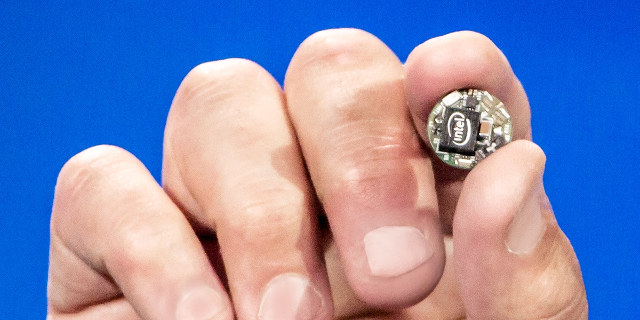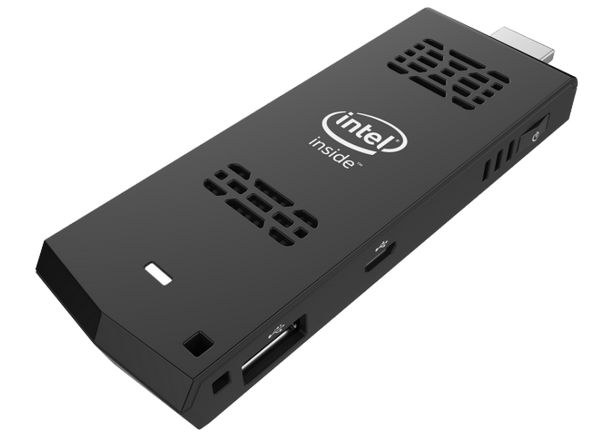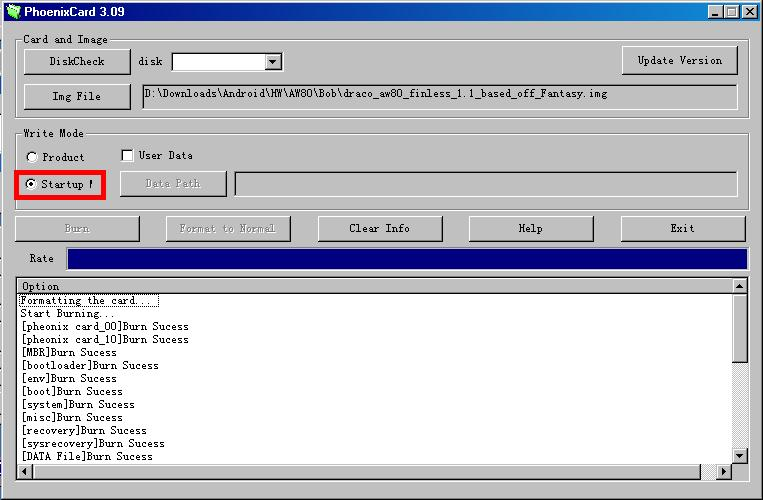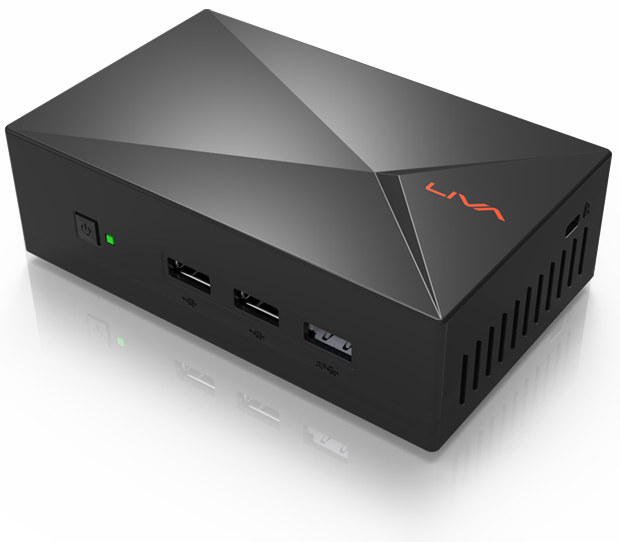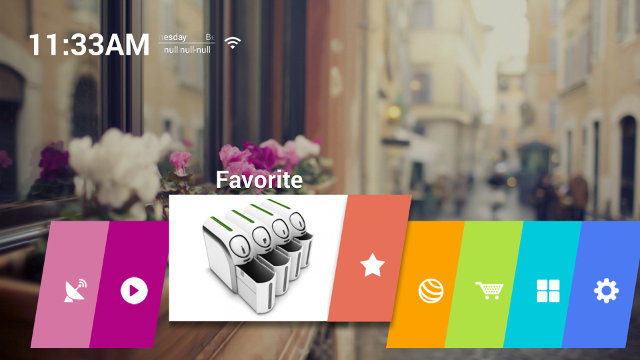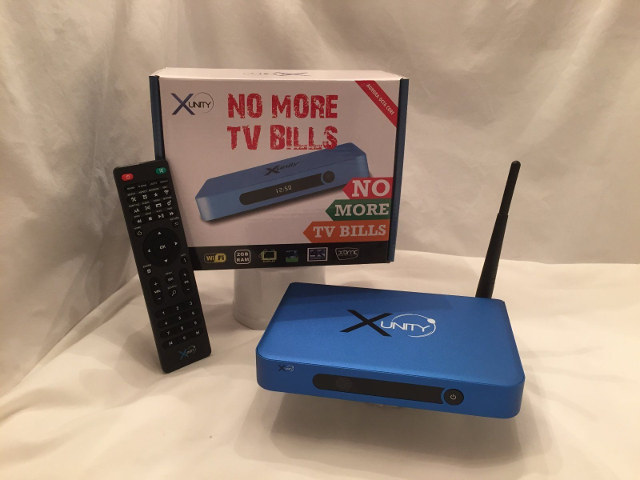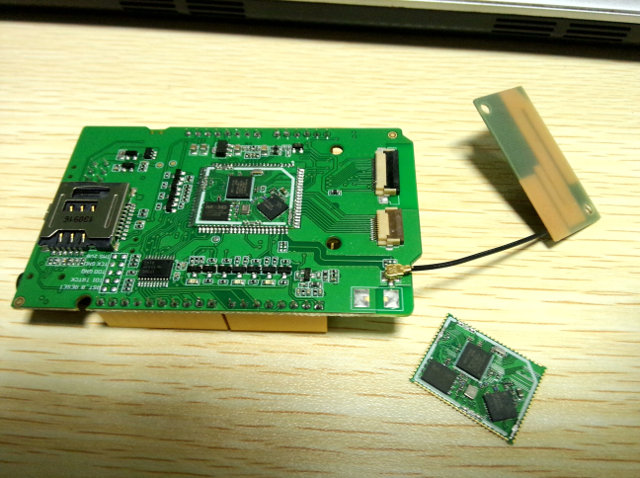Intel announced the Edison board at CES 2014, a board targetting wearables and IoT applications about the size of an SD card. At CES 2015, the company has gone smaller, by unveiling the button-sized Intel Curie module powered by a new Intel Quark SE SoC with a motion sensor, Bluetooth Low Energy connectivity and battery charging capabilities. Intel Curie specifications: Low-power, 32-bit Intel Quark SE SoC 384kB Flash memory, 80kB SRAM Low-power integrated DSP sensor hub with a proprietary pattern matching accelerator Bluetooth Low Energy 6-axis combo sensor with accelerometer and gyroscope Battery charging circuitry (PMIC) The module runs an unnamed open source RTOS, and the company will provide IQ software kits for references applications for wearables, such as counting steps, apps for mobile device, and so on. Intel Curie is expected to be found in smart products such as rings, bags, bracelets, pendants, fitness trackers and buttons. There’s basically no […]
Intel Compute Stick HDMI TV Dongle Runs Windows or Ubuntu for as Low as $89
People got really interested in low cost small factor Intel devices at the end of the year, and one of my article about MeegoPad T01, an HDMI TV Stick powered by an Intel Atom Z3735F processor, even made it to the top 10 posts of 2014 on this blog. But instead of simply relying on partners, Intel had decided to enter the fray with Intel Compute Stick that will run Windows or Ubuntu on an Atom Bay Trail processor. There will actually be two versions of the hardware one for Windows 8.1 with Bing with 2GB RAM, and 32GB storage, and one for Linux with 1GB RAM, and 8G Storage. Intel Compute Stick preliminary specifications: SoC – Unnamed Intel Atom “Bay Trail” processor System Memory – 2 GB RAM (Windows) or 1 GB RAM (Linux) Storage – 32 GB eMMC (Windows) or 8 GB eMMC (Linux) + micro SD slot […]
Easily Create an Android Bootable SD Card for Allwinner A80 Devices with PhoenixCard Tool
We’ve already seen how it was possible to boot Linux or Android on Rockchip RK3288 devices from an SD card, which involved getting the stock firmware and running some scripts in Linux. Today, Freaktab member no_spam_for_me found out how to create a bootable SD card for Tronsmart Draco AW80 Meta, and other Allwinner A80 devices using PhoenixCard 3.09 tools for Windows (The latest version should be available @ http://dl.cubieboard.org/model/cc-a80/Tools/Flash-firmware-tools/). There may also be a way to use LiveSuit tools for Linux, but this have not been tested. Once you have installed the tools, start it, and load the firmware by clicking on “Img File” button (Here Draco AW80 Finless 1.1 firmware was used). Then press DiskCheck to scan for storage devices, and select your SD card in the drop-down menu “disk” (not sure why it’s blank in the screenshot above), select “Startup !” write mode, and click on the “Burn” […]
ECS LIVA X Bay Trail Mini PCs Support Up to 4GB RAM, Windows and Linux OS
ECS LIVA was on of the first Bay Trail mini PC available on the market, and included both memory and storage. Elitegroup Computer System (ECS) has now officially announced an upgrade at CES 2015 with ECS LIVA X, another Bay Trail-M/I mini PC with up to 4GB, and 64GB storage. LIVA X specifications: SoC – Intel Bay Trail-M / I SoC up to 2.25 GHz. The M version is most probably featuring a dual core Celeron N2808 processor. System Memory – 2 or 4GB DDR3L Storage – 32 or 64GB eMMC + mSATA for SSD. 64Mb SPI Flash ROM with AMI BIOS. Video Output – 1x HDMI, 1x VGA. Dual independent displays supported. Audio – 1x audio combo jack (LIne In and Mic IN); Realtek ALC283 HD codec Connectivity 1x Gigabit Ethernet (Realtek RTL8111G) 802.11 b/g/n Wi-Fi and Bluetooth 4.0 USB – 1x USB 3.0, 2 x USB 2.0 […]
$89 Lenovo VIBE Band VB10 Activity Tracker Features an E-Ink Display, 7-Day Battery Life
Last year, when I bought a cheap fitness band with an OLED display, I thought even if I don’t end up using the fitness features, I could also use it as a watch. I was wrong, or at least partially wrong, as although it displays the time, you need to press a button to make it show up, the display is unreadable under the sun, and you need to charge the thing every two days. Lenovo VIVE Band VB10 fitness band, announced at CES 2015, promises to greatly improve on all these issues thanks to an always on E-Ink display, which also helps it achieve 7-day battery life. This device is all the more interesting as it will only cost $89, and looks really good. The full technical details are not available yet, but we do know the display will support up to 150 characters, good enough to display SMS, […]
How to Take Screenshots and Record Videos in Android mini PCs without Root Access
I’ve started to test BFS 4KH Android TB box featuring HiSilicon HI3798M processor. I’m also the first things I normally do is to check for built-in screenshot support, and if not, I simply install a screenshot app like Screenshot Ultimate. This normally works pretty well, but the firmware is not rooted, and the usual root method for HiSilicon devices does not work, as it fails at the adb root stage with the message: “aabd cannot run as root in production builds”. So I was out of luck, and people who sent the sample for review do not seem to check / answer their email in a timely manner. ScreenShot Ultimate provides “No Capture Method Help“, but I found the instructions long, and it required me to install download and install something extra. So instead I check if I could do something with adb instead. adb can connect via USB or […]
Xunity Aurora is an XBMC Linux TV Box Powered by Amlogic S802 Processor
There are plenty of Android media players on the market, and Linux only TV boxes with recent processors have become a rarity. One of them is Armada Mach 8 Pure Linux based on Shenzhen Tomato / Eny M8 hardware, and a new device called Xunity Aurora, also powered by Amlogic S802 quad core processor, will run Linux based on an hardware platform that looks very much like Zoomtak T8. Xunity Aurora specifications: SoC – Amlogic S802 quad core cortex A9r4 @ 2 GHz with Mali-450MP6 GPU @ 700 MHz System Memory – 2GB DDR3 Storage – 8GB NAND flash + SD card slot Connectivity – 10/100M Ethernet, dual band 802.11 b/g/n Wi-Fi with external antenna, Bluetooth 4.0 Video Output – HDMI 1.4a up to 4K30, composite output (RCA) Audio Output – HDMI, stereo RCA, and optical S/PDIF Video Containers – DAT, MPEG, MPE, MPG, TS/TP, VOB, ISO, AVI, MP4, MOV, […]
LinkIt A-Core Packs Mediatek MT2502A SoC into a Tiny Module for Wearables
LinkIt ONE is a development board based on Meditak MT2502A SoC for wearables, and developed by SeeedStudio. With GPS, Wi-Fi, and GSM/GPRS connectivity, and a LiPo battery, it’s great to experiment IoT or wearable applications, but if you plan to launch an actual product, it could be nice to have a module, and built a baseboard around it. That’s exactly what SeeedStudio is working with LinkIt A-Core module. LinkIT A-Core module specifications: SoC – Mediatek MT2502AV ARM7 SoC @ 260 MHz with 32MB PSRAM and 32MB Flash on-chip. External Storage – 16M external Flash (MX25U12835F) Cellular Connectivity – GSM/GPRS quad-band 850/900/1800/1900MHz with RF7198 RF transmitter. Connectivity – Bluetooth 2.0 / 2.0 EDR / 4.0, GPS compatible GPS/GNSS (requires external GPS module) Expansion – 48 general purpose digital I/O Power supply: DC 3V~4.2V Power Consumption – > 3mA Dimensions – 19x23x2 mm The module is still in development, and the company welcomes […]


